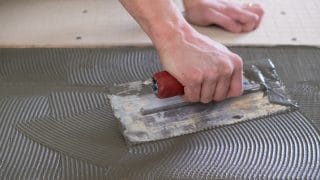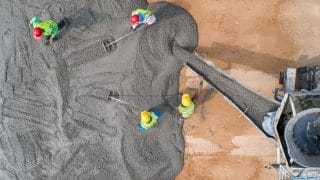
“Use the right fasteners and the right anchors in the right situations and you’ll be much happier than just throwing a dry wall screw in for absolutely every application that you can think of.” – Jordan Smith
When you need to hang an item on an area of your wall where wall studs aren’t available, a drywall anchor will do the trick. It’s tempting to use a fastener leftover from another project or whatever you have on hand (like a drywall screw), but it’s important to use the right fastener for the job. The object that you are hanging will be more secure and therefore safer, plus you will avoid damaging your walls.
There are a variety of anchors made specifically for safely hanging objects on hollow walls, which range from lightweight jobs like hanging a small picture frame, to holding the weight of a full length mirror. Typically, the anchor package will list the maximum amount of weight that the anchor can hold, the size drill bit(s) you will need to install, and the drywall width the anchor will work with. If you aren’t sure the exact weight of your object, it never hurts to go with the anchor with the highest holding power or weight limit just to be safe.
1. Molly Bolts

Molly bolts may look similar to the small plastic anchors meant for hanging lightweight items, but they are much more heavy duty and more reliable wall mounts. In fact, professional builders should always swap out small plastic expansion anchors for molly bolts (and throw those expansion anchors in the trash).
Molly fasteners are easy to install and secure—great for objects in the mid-weight range from about 25 to 50 pounds. The unique feature of molly bolts compared to other types of wall anchors is that the screw can be removed and reinserted without compromising the anchor. Molly bolts can be made from plastic or heavy duty zinc plated steel, with metal bolts generally being rated to hold greater weights (and last longer).
How to install a molly bolt
- Predrill a hole in the drywall according to the width listed on the packaging.
- Insert the molly bolt into the drywall (tap the anchor in with a hammer if needed).
- Tighten the screw into the anchor to expand it and press it firmly against the drywall backing.
- Unscrew the fastener from the anchor as needed to attach the object you are hanging.
Note: Molly bolts are suitable for use in ceilings and best for lightweight to medium weight objects like smoke alarms, picture frames, television stands, and more. Check the packaging for an exact weight range your specific anchors can hold.
Why don’t structures fall down or come apart? Learn all about the stuff that holds building materials together in the MT Copeland online Fasteners and Adhesives course. Taught by professional builder Jordan Smith, the course covers topics ranging from nails and screws to glues and epoxies.

2. Toggle Bolts
Like molly bolts, metal toggle bolts are another type of hollow wall anchor that can do heavy lifting. Toggle bolts push through a predrilled hole and the winged head snaps open on the other side to secure the bolt to the wall. They are a little bit harder to keep level as you tighten and you cannot remove the screw once tightened, but they are a heavy duty anchor rated for objects up to about 100 lbs, or as marked.
“Use the right fasteners and the right anchors in the right situations and you’ll be much happier than just throwing a dry wall screw in for absolutely every application that you can think of.” – Jordan Smith
When you need to hang an item on an area of your wall where wall studs aren’t available, a drywall anchor will do the trick. It’s tempting to use a fastener leftover from another project or whatever you have on hand (like a drywall screw), but it’s important to use the right fastener for the job. The object that you are hanging will be more secure and therefore safer, plus you will avoid damaging your walls.
There are a variety of anchors made specifically for safely hanging objects on hollow walls, which range from lightweight jobs like hanging a small picture frame, to holding the weight of a full length mirror. Typically, the anchor package will list the maximum amount of weight that the anchor can hold, the size drill bit(s) you will need to install, and the drywall width the anchor will work with. If you aren’t sure the exact weight of your object, it never hurts to go with the anchor with the highest holding power or weight limit just to be safe.
1. Molly Bolts

Molly bolts may look similar to the small plastic anchors meant for hanging lightweight items, but they are much more heavy duty and more reliable wall mounts. In fact, professional builders should always swap out small plastic expansion anchors for molly bolts (and throw those expansion anchors in the trash).
Molly fasteners are easy to install and secure—great for objects in the mid-weight range from about 25 to 50 pounds. The unique feature of molly bolts compared to other types of wall anchors is that the screw can be removed and reinserted without compromising the anchor. Molly bolts can be made from plastic or heavy duty zinc plated steel, with metal bolts generally being rated to hold greater weights (and last longer).
How to install a molly bolt
- Predrill a hole in the drywall according to the width listed on the packaging.
- Insert the molly bolt into the drywall (tap the anchor in with a hammer if needed).
- Tighten the screw into the anchor to expand it and press it firmly against the drywall backing.
- Unscrew the fastener from the anchor as needed to attach the object you are hanging.
Note: Molly bolts are suitable for use in ceilings and best for lightweight to medium weight objects like smoke alarms, picture frames, television stands, and more. Check the packaging for an exact weight range your specific anchors can hold.
Why don’t structures fall down or come apart? Learn all about the stuff that holds building materials together in the MT Copeland online Fasteners and Adhesives course. Taught by professional builder Jordan Smith, the course covers topics ranging from nails and screws to glues and epoxies.

2. Toggle Bolts
Like molly bolts, metal toggle bolts are another type of hollow wall anchor that can do heavy lifting. Toggle bolts push through a predrilled hole and the winged head snaps open on the other side to secure the bolt to the wall. They are a little bit harder to keep level as you tighten and you cannot remove the screw once tightened, but they are a heavy duty anchor rated for objects up to about 100 lbs, or as marked.
How to install a toggle bolt
- Predrill a hole in the drywall according to the width listed on the packaging. Typically you must drill a hole three times the size of the bolt in order to fit the toggle through the opening.
- Insert the toggle bolt into the drywall. The wings will be folded in as you push it through.
- Screw in the bolt to expand the toggle and press it firmly against the drywall backing.
Note: Toggle bolts are suitable for use in ceilings for medium weight objects (up to about ⅓ the weight rating) and essential for heavy items like wall mirrors, large picture frames, hooks for hanging objects, and more.

3. Self-drilling drywall anchors
Self-drilling drywall anchors, or threaded anchors, are another type of drywall anchor that can handle hanging the heaviest of objects. The sharp, threaded end is self-drilling meaning you do not need to predrill a hole for installing this anchor. As you screw in the bolt, the drilling end will flip to press up against the back of the drywall and sandwich the anchor in place. These heavy duty anchors can hold up to 110 lbs, or as marked.
How to install a self-drilling drywall anchor
- Simply place the sharp end of the anchor on the wall and screw in the bolt to drive the anchor in.
- Tighten the bolt as needed to ensure the anchor is hooked tightly against the wall.
Note: Self-drilling drywall anchors are not suitable for use in ceilings but are essential for heavy items like wall mirrors, large picture frames, hooks for hanging objects, and more.

4. Expansion drywall anchors
Expansion drywall anchors are the small, plastic conical anchors that you’ll often find in the standard drywall anchor kit that comes with lightweight home fixtures like curtain rods, toilet paper roll hangers, and sometimes picture frames. Unlike the other anchor types that lock to the back of the drywall, these anchors expand within the width of the drywall and can break down the drywall over time.
Jordan does not recommend this type of anchor for anyone working as a builder.
Note: If you are hanging an item on a concrete or brick wall, you will use a special concrete expansion anchor that looks like a molly bolt but functions like an expansion anchor. It’s easy to confuse these anchors with the low quality plastic drywall anchors, so read the packaging to double check the recommended wall type before you buy.
How to install an expansion drywall anchor
- Predrill a hole in the drywall according to the width listed on the packaging.
- Insert the anchor into the drywall (tap the anchor in with a hammer if needed).
- As you turn the screw into the anchor, it will expand within the drywall.
Note: Expansion anchors are only designed to do light duty work around 5lbs to 20 lbs max—a molly bolt is always a better option. Even the zinc plated metal options will not last long once installed.
MT Copeland offers video-based online classes that give you a foundation in construction fundamentals with real-world applications. Classes include professionally produced videos taught by practicing craftspeople, and supplementary downloads like quizzes, blueprints, and other materials to help you master the skills.







